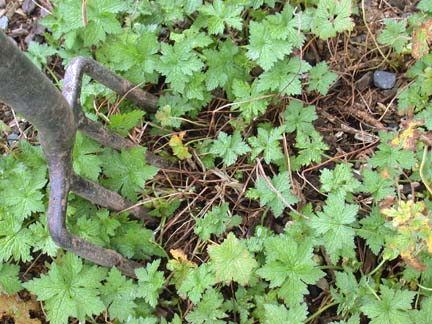|
March 18, 2004
Making more plantsby AMY STEWART AUTUMN IS INDISPUTABLY THE BEST
TIME TO DIVIDE perennials and make more plants in your garden
-- the plants are dormant and less bothered by being split in
half, and they can spend the rainy winter putting down new roots.
But I can't resist taking some cuttings and divisions in the
springtime, too. Summer-blooming perennials are just leafing
out and won't be in bloom for a few more months, and now that
I've cleaned away the winter debris and pulled some weeds, I
can see all the empty spots that are just waiting to be filled
with new plants. Also, by dividing the perennials that are already
doing well in my garden, I'm adding plants that I know will thrive. Low-growing, mounding perennials respond well to divisions this time of year, recovering quickly and usually blooming the same season they were divided. Some gardeners describe these as "shoes and socks" plants because they hide the "legs" of woody perennial shrubs, creating an appealing layering effect that pulls the garden together and fills in bare patches. Even if you don't have any of these plants growing in your garden, you can still take advantage of the ease with which they can be divided. Just look around at the nursery for mature, almost (but not quite) root bound plants, and divide them before you even put them in the ground. Three 4-inch pots of yarrow, for instance, can yield a dozen plants or more if you divide them carefully. Catmint (Nepeta, various cultivars) is one of the easiest plants to divide, and it makes an excellent groundcover and a good companion plant to bulbs, filling in the gaps and covering the scraggly foliage after the bulbs have bloomed. The foliage is silvery-green and the flowers come in shades of pink, white, and purple. `Walker's Low' is a good ground-hugging variety, and `Six Hills Giant' is known for its upright habit and sturdy flowers on long stalks, making it a more substantial border plant and a good choice for cut flowers. While cats are attracted to catmint, it is not quite as intoxicating as catnip (Nepeta cateria), which, in my garden, rarely survives the affections of the neighborhood felines. Cranesbill geraniums are also surprisingly easy to divide this time of year, while they are putting out new growth and getting ready to bloom. These low-growing, mounding plants with finely toothed leaves also sport a wide variety of colors, from pink and white to blue, purple and magenta. `Johnson's Blue' is one of the most popular cultivars, but there's a wide variety to choose from, and they will perform well in partial shade or sun. Other perennials that divide easily this time of year include yarrow, lady's mantle, thyme, oregano and heuchera. Many of these plants don't just tolerate regular divisions -- they actually require it. Heuchera, for instance, gets woody and stops blooming if it is not divided every few years. The division of low-growing mounding perennials could not be easier: Just lift the plants out of the ground with a spading fork, trying to preserve as much of the root system as possible. Shake the soil out of the roots and tease the plants apart carefully, making sure that each clump has some roots attached. Some perennials, like thyme, will fall apart with almost no effort. Others, like catmint, may require a bit more effort. You can lay the plant down on the ground and split it into thirds with the blade of a shovel, or put two hand forks in the center of the plant and pull apart. Make sure the roots are not allowed to dry out -- either plant the divisions immediately, or store them in moist potting soil. For more ideas about dividing perennials, check out DK's colorful Plant Propagation by Alan Toogood or Ken Druse's award-winning Making More Plants: The Science, Art, and Joy of Propagation. -- -- -- Once you've made all the plants you can with what you've got, head over to the Manila Community Center for the annual Free Plant Exchange, which they are hosting in partnership with the Humboldt Permaculture Guild. (Permaculture, for the uninitiated, is an approach to gardening that encompasses organic, sustainable techniques, favors low inputs and self-sufficiency, uses native plants whenever possible, and has as its goal the provision of not just food, but also materials for shelter, fuel and livestock habitat.) The goal of the event is to encourage people to garden more and to increase local food security and self-sufficiency. You'll be able to exchange plants and seeds, share information and resources, attend workshops and eat some free food. In fact, not only is the event free of charge, you don't have to bring any seeds or plants to swap. "It's quite literally a free-for-all," organizer Megan Cerri told me. "Bring what you have and take what you need. It's OK to come if you don't have anything to share. And we're offering a carpool if you don't have a way to get out to Manila." The plant and seed exchange begins at noon on Sunday, March 21. At 1:30, Angela Flynn of Humboldt Greengenes will give a talk on GMOs and a proposed initiative to ban the growing of genetically modified crops in Humboldt County. At 2:30, the Wild Urban Gardeners will give a workshop on Urban Gardening. An open discussion on future permaculture activities in Humboldt County will happen at 3 p.m., followed by a free meal of polenta and organic greens at 3:30. About 200 people attended the event last year; the organizers hope to see many more this year. The carpool leaves from the Arcata Co-op kiosk at noon; for more information, call 825-7125. garden-related announcements and news to Amy Stewart. IN
THE NEWS | COVER STORY | ARTBEAT © Copyright 2004, North Coast Journal, Inc. |


